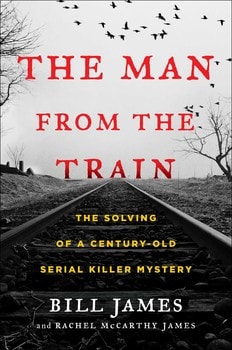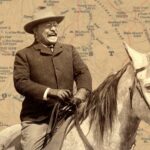It is a warm night, most often on a weekend. There is a very small town with a railroad track that runs through the town, or sometimes along the edge of it. You can’t get more than a few hundred feet away from the railroad track and still be in the town. He is looking for a house with no dog. He would prefer a house on the edge of town, just isolated enough to provide a little bit of cover. A big two-story house would be best, with a family of five. A barn where he can hide out from sundown until the middle of the night, but in that era, before the automobiles came, almost every house had a barn; even the houses in Chicago and Philadelphia had barns. He is looking for a house with a woodpile in the front yard, and an axe sticking up out of the woodpile.
Villisca
The Devil came to Villisca on June 9, 1912, and to this day, if you mention “Villisca” to anyone from Iowa, the first thing they will think about is the murders. It was a Sunday night, and the streetlights were out due to a dollars-and-cents dispute between the city and the power company. Without lights the overcast skies had returned Villisca to the choking blackness that was a normal part of human experience until late in the 19th century, but which many people now have never experienced.
There was a Children’s Day service at the Presbyterian church; Josiah and Sarah Moore and their children attended and participated in the service, which Sarah had helped to organize. At the end of the service two little girls who were friends of Katherine Moore, Ina and Lena Stillinger, went home for the night with the Moore family. There were eight people that night in the Moore house: J. B. and Sarah Moore, their four children, ranging in age from five to eleven, and the two Stillinger girls. On the morning of June 10 the house was quiet. At 7 am a neighbor noticed that no one was stirring outside, and chores were not being done. The chickens had been left squawking in the chicken coop. She knocked on the door, but the door was locked and there was no answer. She let the chickens out of their coop and called Ross Moore, who was J.B.’s brother. Ross Moore had a key to the house.
As the neighbor waited on the porch he forced open the door and went in. Everyone in the house was dead. Eight people had been murdered with an axe inside a locked house in a small, quiet midwestern town. The Man from the Train had struck again, and vanished once more into the blackness of the night.
*
The Bloody Penny
“Buchanan county Va., in which Hurley is located, is very sparsely settled and is very rugged,” reported the Washington Post. “Communication by telephone and telegraph is decidedly limited and slow, making the scene of the tragedy practically inaccessible, and details of the developments exceedingly hard to secure.” The first newspaper accounts of the Meadows family murders, published the day after the crime, state that “bloodhounds were rushed to the scene and in a short time they took up the trail of three supposed murderers in a cornfield which adjoined the home. There the foot prints of three men were found impressed in the soft soil. A posse of citizens, heavily armed, are following the bloodhounds, bent on lynching the murderers if they are captured.” The murders occurred in a log cabin on a mountain in Virginia in a place that is about five miles east of Kentucky, about five miles west of West Virginia, and—perhaps of more relevance to our story—within a mile of the railroad.
On the night of September 21, 1909, six persons were murdered, and the cabin that had been their home was set on fire. The man of the house, George Meadows, was found outside the cabin with his skull crushed and two bullet holes in his torso, his head nearly cut off. He was found half-dressed, and with a pencil in his hand. The log cabin had belonged to his mother-in-law, Betty Justus, who was known to the community as Aunt Betty. Her body was inside the charred remains of the cabin, in yet worse condition than George’s; her head was found some distance from her body. Lydia Meadows, George’s wife, was also inside, also murdered with an axe or a hatchet, as were their three children, Will, Noah, and Lafayette, all less than ten years old.
The scene of the Meadows family murders was variously identified in the newspapers as Hurley, Knox, Knox Creek, and Laurel Creek; let us say that it was Hurley, Virginia, because that at least is a real place that you can find on a map. A road zigzags through the mountains just north of Hurley; the house sat along that road. Newspaper reports filed on the day of the crime say that the posse following the bloodhounds numbered 300 men. The town’s chief employer, the Ritter Lumber Mill, shut down for at least two days so that workers would be free to participate in the chase.
The bloodhounds followed a trail across the mountains for the better part of a day and for ten miles, arriving finally at the mountain cabin of Silas Blankenship. At one point the trail led to a sheer rock wall as high as a man’s head, which the hounds and posse had to scramble over. At last they did indeed find three men, Blankenship and his two sons, who were digging potatoes when they heard bloodhounds baying and looked up to see a large mob of angry farmers rushing toward them. The Blankenships fled to their cabin, bolted the doors, and poked shotguns out of “loopholes” in the walls, apparently designed for exactly such a purpose. The Blankenships promised to blow the heads off of anyone who approached the cabin.
It was a credible promise, and a six-hour standoff ensued. Six murders, bloodhounds, an angry mob of hundreds of men with ropes and guns, and three men barricaded inside a cabin with shotguns. It’s a hell of a scene; this occurred September 23, 1909, in the mountains near Hurley, Virginia. Many in the posse wanted to rush the cabin and set fire to it. Cooler heads prevailed.
The Commonwealth’s attorney, a man named Scores, hurried to the scene with a crew of special deputies, well-armed just in case there weren’t enough guns already on-site. Eventually the Blankenships were promised safe passage to jail, the mob was dispersed, and the Blankenships surrendered.
But the United Press reported the next morning that “the farmers of Buchanan and adjoining counties are gathering at Hurley and it is believed they will attack the jail and lynch the suspects.”
The Blankenships were arrested on a charge of murder; it is a measure of how different our justice system was a hundred years ago, that three men could be charged with murder based on nothing but the baying of some bloodhounds. First reports were that blood-soaked clothing had been found at the Blankenship house. The Blankenships were men of good reputation, however, and it is fortunate that they were not hanged or set afire; it turned out they were innocent. They had an alibi for the night in question, and nothing of any substance tied them to the crime.
The governor of Virginia was Claude Swanson. On September 27, Governor Swanson offered a $250 reward for information leading to the arrest and conviction of perpetrators. A process was also established by which citizens could “subscribe,” intended to raise another $2,000 to $5,000 in order to pay for detectives to find the murderers. Before the reward was offered, however, the man who would eventually be convicted of the crime was already under arrest in West Virginia.
Howard Little was ironically named. At the time of his execution the newspapers referred to him as a “handsome giant,” and a photo of him in custody, guarded by six armed men, shows a powerfully built man a head taller than anyone else in the photo. He was not an inconsiderable man. In his youth he had worked as a United States Marshal in Kentucky or perhaps as an assistant to one, and, after moving to Virginia, had been made foreman of a large lumber company. He was intelligent, assertive, and he worked hard. He was also a lothario—a Don Juan, as the papers said at the time.
Married with four children, Little had made plans to leave his wife. He had been carrying on with a married woman, a Mrs. Mary Stacy; Little and Stacy were making arrangements to skip town together, although it is anyone’s guess whether Little actually intended to follow through on this.
Local authorities turned immediately to private detectives for help in the investigation, which was standard practice at the time. The detective agency brought into the case was the Baldwin-Felts Agency in Bluefield, West Virginia—a substantial and professional agency. In this era, good private detective agencies had resources to investigate a crime that vastly exceeded the resources of small-town sheriffs—and, in many cases, exceeded the resources even of the biggest and best metropolitan police agencies. One of those resources was that they maintained good records of known criminals living in the area.
Howard Little had once been convicted of murder in Kentucky—a fact not known to the community in which he lived, but included in the files of the private detectives—so he was immediately of interest to the Baldwin agency. He was, of course, hardly the only known criminal living in the area, but there were other facts against him. On Thursday morning after the murders on Tuesday night, an agent from the company dropped by the Little home for a conversation. The conversation did not go well. Little had spent most of the evening in question away from his home, returning home long after midnight, his jacket wet and carrying a lantern of unknown provenance. He had a cut on his leg. He had no alibi that he could share, and his wife was not supportive. He had recently borrowed a revolver from a friend.
*
In June 1892, while working as a US Marshal, Little had murdered a man named Jacob Kinney (name also reported as George McKinney) in Pike County, Kentucky, which is just across the border from Hurley. Little and Kinney had been rivals for the affection of a young woman. Little was 38 years old at the time of his death, which would mean that he was 20 years old at the time of the earlier murder. He was convicted of that crime and sentenced to a life term in prison, but had been pardoned by the governor of Kentucky after serving four years.
Little was arrested by six men led by Lee Felts, a brother of the named partner in the Baldwin-Felts Agency; he was arrested in Bull Creek, West Virginia, on September 24. (Lee Felts and a third brother, Albert Felts, were among those killed in the Matewan Massacre in 1920.) Little was held for a week in Welch, West Virginia, 37 miles east of Hurley, his arrest kept quiet for five days to circumvent another lynch mob and also, probably, to allow the reward fund time to build up, so that the Baldwin-Felts Agency would make more money when they stepped forward to claim the reward. Felts told reporters on October 1 that “he believes that Little committed the crime single-handed,” although up until—and after—the arrest was made the theory of the investigators was that the crime had been committed by a gang of three robbers.
Two friends of Little, named by the newspapers, were investigated for a connection with the crime, but had solid alibis. Meadows had been buried with two bullets in his body. Detective Felts now ordered that the body be exhumed and the bullets removed. On October 2 investigators dug up the body and removed the bullets, and announced immediately that the bullets fit the revolver that Little had borrowed. There were no ballistics in 1909; what was meant by the statement that the bullets “fit” the revolver was that they were of the right size, the right weight and caliber, that they could have been fired from that pistol, which was a .32 caliber pistol.
Little was moved to a jail in Grundy, Virginia, 16 miles south of Hurley, and then, fearing another effort to lynch him, to a jail in Lebanon, Virginia, about 55 miles to the south of Hurley.
Between Grundy and Lebanon is the small town of Honaker, Virginia. Getting word that the prisoner was to be moved, a mob of 75 to 100 armed men gathered in Honaker, planning to intercept the police officers as they came through. The mob cut all the telephone wires between Grundy and Lebanon, to prevent word getting out of their plans, but police officers sniffed out the effort, moving the prisoner 30 miles through the mountains with the aid of horses and mules.
Mrs. Little had told police that she could show them where her husband had hidden the money from the robbery. She was unable to deliver on this promise. The money was never found, and, in fact, there is no real evidence that any money was ever taken.
A lawyer named Bert T. Wilson was retained to defend Little. In prison Little lost weight, a lot of weight in a little time, and spent his hours reading the Bible. Troops were provided for Little’s protection before and during the trial. The first witness was Senate Justus, an adult son of the murdered Betty Justus. Justus had worked with Little at the Ritter Lumber Company; Little was his foreman. Justus claimed that Little had asked him “frequently” how much money his mother carried around with her. Another witness—not identified by name in the reports of the trial—said that Little had said to him that she shouldn’t keep money around like that, because it would be an easy matter for someone to rob her, murder the family, and set fire to the house.
Mary Stacy, the woman with whom Little had been planning to leave town, testified that Little gave her $20 on the day before the murders in order to buy clothes to get ready for the trip, and had told her that they would be ready to go as soon as he was able to get some money out of his bank. The most important witness of the trial was a woman named Mary Lee. Mary Lee, for reasons unknown, lived with the Little family; she may have been a governess or housekeeper, or she may have been a relative. The common understanding of the law at that time was that a wife could not testify against her husband, and Mrs. Little did not testify. Miss Lee became the most important witness because she could testify to what the wife could not.
__________________________________
From The Man from the Train, by Bill James and Rachel McCarthy James, courtesy Scribner. Copyright 2017, Bill James and Rachel McCarthy James.


















